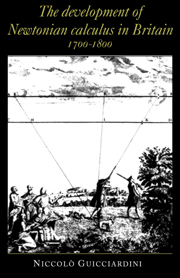Book contents
- Frontmatter
- Contents
- Introduction
- OVERTURE: NEWTON'S PUBLISHED WORK ON THE CALCULUS OF FLUXIONS
- PART I THE EARLY PERIOD
- 1 THE DIFFUSION OF THE CALCULUS (1700–30)
- 2 DEVELOPMENTS IN THE CALCULUS OF FLUXIONS (1714–33)
- 3 THE CONTROVERSY ON THE FOUNDATIONS OF THE CALCULUS (1734–42)
- PART II THE MIDDLE PERIOD
- PART III THE REFORM
- CONCLUSION
- APPENDIX A TABLES OF CONTENTS OF FLUXIONARY TEXTBOOKS
- APPENDIX B PRICE LIST OF MATHEMATICAL BOOKS PRINTED FOR JOHN NOURSE
- APPENDIX C CHAIRS IN THE UNIVERSITIES
- APPENDIX D MILITARY ACADEMIES
- APPENDIX E SUBJECT INDEX OF PRIMARY LITERATURE
- APPENDIX F MANUSCRIPT SOURCES
- Notes
- Bibliography
- Index
2 - DEVELOPMENTS IN THE CALCULUS OF FLUXIONS (1714–33)
from PART I - THE EARLY PERIOD
Published online by Cambridge University Press: 14 September 2009
- Frontmatter
- Contents
- Introduction
- OVERTURE: NEWTON'S PUBLISHED WORK ON THE CALCULUS OF FLUXIONS
- PART I THE EARLY PERIOD
- 1 THE DIFFUSION OF THE CALCULUS (1700–30)
- 2 DEVELOPMENTS IN THE CALCULUS OF FLUXIONS (1714–33)
- 3 THE CONTROVERSY ON THE FOUNDATIONS OF THE CALCULUS (1734–42)
- PART II THE MIDDLE PERIOD
- PART III THE REFORM
- CONCLUSION
- APPENDIX A TABLES OF CONTENTS OF FLUXIONARY TEXTBOOKS
- APPENDIX B PRICE LIST OF MATHEMATICAL BOOKS PRINTED FOR JOHN NOURSE
- APPENDIX C CHAIRS IN THE UNIVERSITIES
- APPENDIX D MILITARY ACADEMIES
- APPENDIX E SUBJECT INDEX OF PRIMARY LITERATURE
- APPENDIX F MANUSCRIPT SOURCES
- Notes
- Bibliography
- Index
Summary
despite its minor role in the diffusion of Newtonian science, we might expect the calculus of fluxions to have been the main subject of research in early eighteenth-century British mathematics. Scientists of outstanding ability were active in Great Britain. Some of them, such as Cotes, Taylor, Maclaurin and Stirling, were good mathematicians who were able to master every aspect of Newton's work on fluxions. But British mathematicians devoted more attention to other branches of Newton's mathematics: i.e. the geometry of higher order curves and the method of series. The reason why the calculus of fluxions was not considered a fruitful area of research is that it appeared to have been developed by Newton to the highest level of perfection. For instance, in 1721 Colin Maclaurin wrote:
The Quadratures [i.e. Newton (1704c)] brought to such generall [sic] theorems that little further seems left to be done in that vast feild [sic] of Invention.
(Maclaurin (1982), p. 13)The direct method allowed one to find the fluxion of all the known fluents, whereas the inverse method required term by term integration of power series. One of the problems left open was to speed up the convergence of series; a problem which could be treated by finding appropriate transformations involving finite differences. Newton's ‘Methodus differentialis’ (1711c) appeared more incomplete than ‘De quadratura’ (1704c). Also, Newton's ‘Enumeratio’ (1704b) was more problematic in the classification of cubics.
- Type
- Chapter
- Information
- Publisher: Cambridge University PressPrint publication year: 1989



